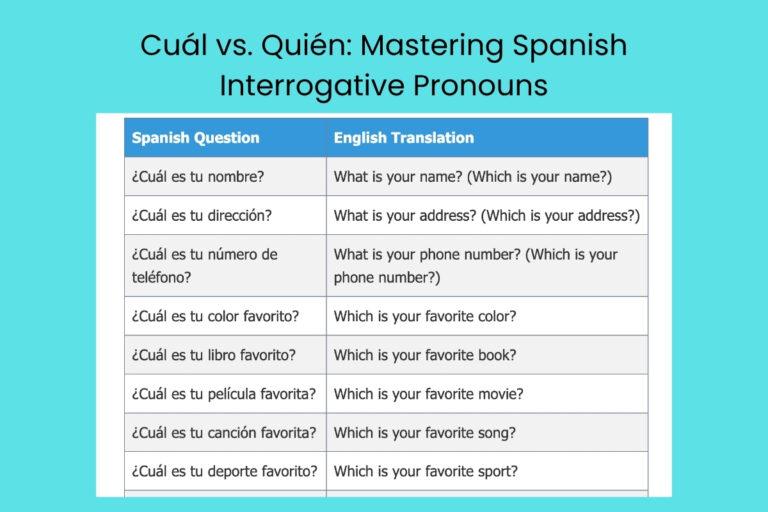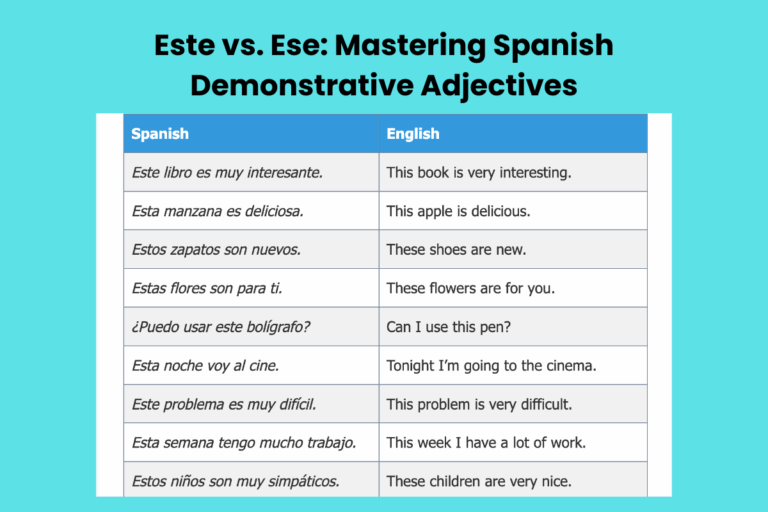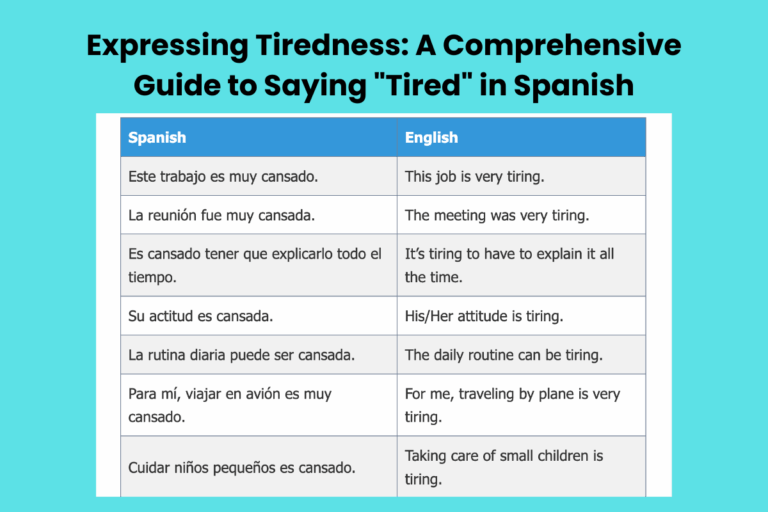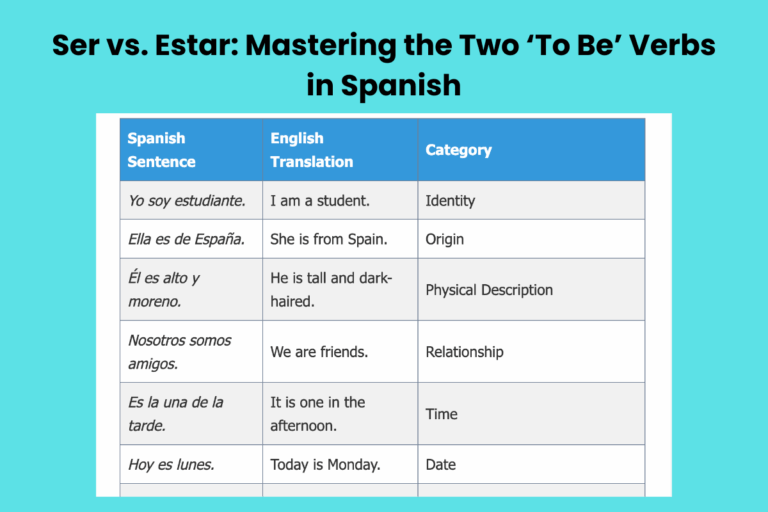Mastering Spanish Ordinal Numbers: A Comprehensive Guide
Understanding Spanish ordinal numbers is crucial for expressing order, sequence, and position, adding depth and precision to your language skills. Unlike cardinal numbers (one, two, three), ordinal numbers indicate the place of something in a series (first, second, third).
This article offers a comprehensive exploration of Spanish ordinal numbers, covering their formation, usage, and common pitfalls. Whether you’re a beginner or an advanced learner, this guide will equip you with the knowledge and practice to confidently use ordinal numbers in various contexts.
This guide is designed for students, travelers, and anyone interested in mastering Spanish grammar. By mastering Spanish ordinal numbers, you can enhance your ability to describe events, locations, and rankings accurately.
This knowledge is essential for navigating daily conversations, understanding written texts, and expressing yourself fluently in Spanish.
Table of Contents
- Definition of Spanish Ordinal Numbers
- Structural Breakdown
- Types or Categories of Ordinal Numbers
- Examples of Spanish Ordinal Numbers
- Usage Rules
- Common Mistakes
- Practice Exercises
- Advanced Topics
- FAQ
- Conclusion
Definition of Spanish Ordinal Numbers
Ordinal numbers in Spanish, known as números ordinales, indicate the position or order of something in a sequence. They are used to specify which item is first, second, third, and so on. Unlike cardinal numbers, which simply count, ordinal numbers denote rank or order. Understanding and using ordinal numbers correctly is essential for clear and accurate communication in Spanish.
Ordinal numbers function as adjectives, meaning they modify nouns. They agree in gender and number with the nouns they modify.
For example, if you are referring to “the first girl,” you would use the feminine singular form of the ordinal number. Ordinal numbers are commonly used in dates, competitions, and when describing a series of events or items.
They are classified as determiners, specifically ordinal determiners, as they specify the position of a noun in a sequence. Their function is to provide order and ranking within a set of items or events.
Ordinal numbers are used in a wide range of contexts, from everyday conversations to formal writing, making them an indispensable part of Spanish grammar.
Structural Breakdown
The structure of Spanish ordinal numbers is generally straightforward. The first ten ordinal numbers have unique forms, while the rest are typically formed by adding suffixes to the cardinal numbers.
Understanding these patterns is key to mastering ordinal number formation. The suffixes added to cardinal numbers to transform them into ordinal numbers are usually ‘-ésimo’ for masculine and ‘-ésima’ for feminine forms.
For numbers ending in ‘-o’ (like uno), the ‘-o’ is dropped before adding the suffix (e.g., primer instead of unoésimo). For numbers ending in consonants, the suffix is added directly (e.g., catorce becomes décimo cuarto). These are usually used for numbers above tenth.
Understanding the gender and number agreement is critical. Ordinal numbers must agree with the noun they modify. For masculine nouns, use the masculine form (e.g., el primer libro – the first book). For feminine nouns, use the feminine form (e.g., la primera casa – the first house). The same applies to plural nouns (e.g., los primeros libros – the first books, las primeras casas – the first houses).
Types or Categories of Ordinal Numbers
Basic Ordinal Numbers (1st – 10th)
The first ten ordinal numbers are unique and must be memorized. They form the foundation for understanding more complex ordinal numbers.
These are frequently used in everyday language and are essential for basic communication.
Compound Ordinal Numbers (11th and beyond)
Ordinal numbers from eleventh onwards are often formed using a combination of décimo (tenth) and the corresponding cardinal number. For example, undécimo (eleventh) can also be expressed as décimo primero. Understanding this pattern simplifies the formation of higher ordinal numbers.
Shortened Forms of First and Third
The ordinal numbers primero (first) and tercero (third) have shortened forms: primer and tercer. These shortened forms are used before masculine singular nouns. For example, you would say el primer día (the first day) instead of el primero día.
Ordinal Numbers in Dates
In Spanish, ordinal numbers are used to indicate the first day of the month. For example, el primero de mayo (the first of May). For all other days, cardinal numbers are used. This is a specific usage rule that is important to remember when writing or speaking about dates.
Examples of Spanish Ordinal Numbers
The following tables provide examples of Spanish ordinal numbers in both masculine and feminine forms, along with their English translations. These examples illustrate how ordinal numbers are used in context and demonstrate the importance of gender agreement.
Examples of Basic Ordinal Numbers (1st – 10th)
This table shows the first ten ordinal numbers in Spanish, along with their English translations. Note the differences in masculine and feminine forms.
| Number | Masculine | Feminine | English Translation |
|---|---|---|---|
| 1st | Primer / Primero | Primera | First |
| 2nd | Segundo | Segunda | Second |
| 3rd | Tercer / Tercero | Tercera | Third |
| 4th | Cuarto | Cuarta | Fourth |
| 5th | Quinto | Quinta | Fifth |
| 6th | Sexto | Sexta | Sixth |
| 7th | Séptimo | Séptima | Seventh |
| 8th | Octavo | Octava | Eighth |
| 9th | Noveno | Novena | Ninth |
| 10th | Décimo | Décima | Tenth |
| 1st (example) | El primer libro | La primera casa | The first book |
| 2nd (example) | El segundo coche | La segunda oportunidad | The second car |
| 3rd (example) | El tercer piso | La tercera vez | The third floor |
| 4th (example) | El cuarto hombre | La cuarta silla | The fourth man |
| 5th (example) | El quinto día | La quinta avenida | The fifth day |
| 6th (example) | El sexto sentido | La sexta pregunta | The sixth sense |
| 7th (example) | El séptimo arte | La séptima maravilla | The seventh art |
| 8th (example) | El octavo mes | La octava sinfonía | The eighth month |
| 9th (example) | El noveno grado | La novena enmienda | The ninth grade |
| 10th (example) | El décimo mandamiento | La décima página | The tenth commandment |
| 1st (date example) | El primero de enero | N/A | The first of January |
| 2nd (example) | Segundo intento | Segunda Guerra Mundial | Second attempt |
| 3rd (example) | Tercer lugar | Tercera fila | Third place |
Examples of Compound Ordinal Numbers (11th – 20th)
This table illustrates compound ordinal numbers from eleventh to twentieth. Notice the use of décimo in combination with the cardinal numbers.
| Number | Masculine | Feminine | English Translation |
|---|---|---|---|
| 11th | Undécimo / Décimo primero | Undécima / Décima primera | Eleventh |
| 12th | Duodécimo / Décimo segundo | Duodécima / Décima segunda | Twelfth |
| 13th | Décimo tercero | Décima tercera | Thirteenth |
| 14th | Décimo cuarto | Décima cuarta | Fourteenth |
| 15th | Décimo quinto | Décima quinta | Fifteenth |
| 16th | Décimo sexto | Décima sexta | Sixteenth |
| 17th | Décimo séptimo | Décima séptima | Seventeenth |
| 18th | Décimo octavo | Décima octava | Eighteenth |
| 19th | Décimo noveno | Décima novena | Nineteenth |
| 20th | Vigésimo | Vigésima | Twentieth |
| 11th (example) | El undécimo mandamiento | La undécima hora | The eleventh commandment |
| 12th (example) | El duodécimo mes | La duodécima enmienda | The twelfth month |
| 13th (example) | El décimo tercero día | La décima tercera semana | The thirteenth day |
| 14th (example) | El décimo cuarto capítulo | La décima cuarta lección | The fourteenth chapter |
| 15th (example) | El décimo quinto aniversario | La décima quinta sinfonía | The fifteenth anniversary |
| 16th (example) | El décimo sexto cumpleaños | La décima sexta película | The sixteenth birthday |
| 17th (example) | El décimo séptimo rey | La décima séptima reina | The seventeenth king |
| 18th (example) | El décimo octavo juego | La décima octava canción | The eighteenth game |
| 19th (example) | El décimo noveno año | La décima novena temporada | The nineteenth year |
| 20th (example) | El vigésimo siglo | La vigésima edición | The twentieth century |
| 11th (date example) | Décimo primero de junio | N/A | Eleventh of June |
| 12th (date example) | Décimo segundo de julio | N/A | Twelfth of July |
Examples of Higher Ordinal Numbers (21st and beyond)
This table provides examples of higher ordinal numbers, demonstrating the patterns used to form them. Note how combinations of cardinal and ordinal components are used.
| Number | Masculine | Feminine | English Translation |
|---|---|---|---|
| 21st | Vigésimo primero | Vigésima primera | Twenty-first |
| 22nd | Vigésimo segundo | Vigésima segunda | Twenty-second |
| 30th | Trigésimo | Trigésima | Thirtieth |
| 40th | Cuadragésimo | Cuadragésima | Fortieth |
| 50th | Quincuagésimo | Quincuagésima | Fiftieth |
| 60th | Sexagésimo | Sexagésima | Sixtieth |
| 70th | Septuagésimo | Septuagésima | Seventieth |
| 80th | Octogésimo | Octogésima | Eightieth |
| 90th | Nonagésimo | Nonagésima | Ninetieth |
| 100th | Centésimo | Centésima | Hundredth |
| 21st (example) | El vigésimo primer aniversario | La vigésima primera edición | The twenty-first anniversary |
| 22nd (example) | El vigésimo segundo capítulo | La vigésima segunda página | The twenty-second chapter |
| 30th (example) | El trigésimo día | La trigésima semana | The thirtieth day |
| 40th (example) | El cuadragésimo cumpleaños | La cuadragésima película | The fortieth birthday |
| 50th (example) | El quincuagésimo año | La quincuagésima temporada | The fiftieth year |
| 60th (example) | El sexagésimo concierto | La sexagésima función | The sixtieth concert |
| 70th (example) | El septuagésimo poema | La septuagésima rima | The seventieth poem |
| 80th (example) | El octogésimo premio | La octogésima medalla | The eightieth award |
| 90th (example) | El nonagésimo minuto | La nonagésima jugada | The ninetieth minute |
| 100th (example) | El centésimo cliente | La centésima visita | The hundredth client |
| 31st (example) | Trigésimo primer lugar | Trigésima primera fila | Thirty-first place |
| 42nd (example) | Cuadragésimo segundo intento | Cuadragésima segunda oportunidad | Forty-second attempt |
Usage Rules
Gender and Number Agreement
Ordinal numbers must agree in gender and number with the nouns they modify. This is a fundamental rule that applies to all adjectives in Spanish.
For masculine singular nouns, use the masculine singular form of the ordinal number. For feminine singular nouns, use the feminine singular form.
The same principle applies to plural nouns.
Shortened Forms: Primer and Tercer
Remember that primero (first) and tercero (third) are shortened to primer and tercer when they precede a masculine singular noun. This is a common rule that can be easily overlooked. For example, “the first day” is el primer día, not el primero día.
Ordinal Numbers in Dates
Use ordinal numbers only for the first day of the month. For all other days, use cardinal numbers. For example, “the first of January” is el primero de enero, but “the second of January” is el dos de enero.
Compound Ordinal Numbers
For compound ordinal numbers (11th and beyond), you can use either the combined form (e.g., undécimo) or the separated form (e.g., décimo primero). Both forms are generally acceptable, but the combined form is more common for numbers up to 20th.
Placement of Ordinal Numbers
Ordinal numbers typically precede the noun they modify, similar to adjectives in Spanish. For example, la primera casa (the first house), el segundo libro (the second book).
Common Mistakes
Incorrect Gender Agreement
Incorrect: El primera casa
Correct: La primera casa (The first house)
Explanation: The ordinal number must agree in gender with the noun. Casa is feminine, so the ordinal number must be primera.
Not Shortening Primero and Tercero
Incorrect: El primero día
Correct: El primer día (The first day)
Explanation: Primero should be shortened to primer before a masculine singular noun.
Using Ordinal Numbers for All Dates
Incorrect: El primero de mayo, el segundo de mayo
Correct: El primero de mayo, el dos de mayo (The first of May, the second of May)
Explanation: Ordinal numbers are used only for the first day of the month. Cardinal numbers are used for all other days.
Incorrect Word Order
Incorrect: Casa la primera
Correct: La primera casa (The first house)
Explanation: Ordinal numbers usually precede the noun they modify.
Mixing Cardinal and Ordinal Numbers
Incorrect: El dos libro
Correct: El segundo libro (The second book)
Explanation: Ensure you’re using ordinal numbers when you mean to indicate order or position, not quantity.
Practice Exercises
Exercise 1: Fill in the Blanks with the Correct Ordinal Number
Complete the following sentences with the correct form of the ordinal number in Spanish.
| Question | Answer |
|---|---|
| 1. Hoy es el ______ (one) de enero. | 1. Hoy es el primero de enero. |
| 2. Vivo en el ______ (three) piso. | 2. Vivo en el tercer piso. |
| 3. Ella es la ______ (two) estudiante de la clase. | 3. Ella es la segunda estudiante de la clase. |
| 4. Este es mi ______ (five) intento. | 4. Este es mi quinto intento. |
| 5. Él es el ______ (ten) hijo de la familia. | 5. Él es el décimo hijo de la familia. |
| 6. La ______ (four) puerta está cerrada. | 6. La cuarta puerta está cerrada. |
| 7. Es la ______ (nine) vez que lo digo. | 7. Es la novena vez que lo digo. |
| 8. Este es el ______ (six) libro de la serie. | 8. Este es el sexto libro de la serie. |
| 9. Es el ______ (eight) día del mes. | 9. Es el octavo día del mes. |
| 10. Es la ______ (seven) maravilla del mundo. | 10. Es la séptima maravilla del mundo. |
Exercise 2: Translate the English Sentences into Spanish Using Ordinal Numbers
Translate the following sentences into Spanish, using the correct ordinal numbers.
| Question | Answer |
|---|---|
| 1. He lives on the second floor. | 1. Él vive en el segundo piso. |
| 2. She is the first student in the class. | 2. Ella es la primera estudiante de la clase. |
| 3. This is my third attempt. | 3. Este es mi tercer intento. |
| 4. Today is the first of July. | 4. Hoy es el primero de julio. |
| 5. It is the fifth time I’ve said it. | 5. Es la quinta vez que lo digo. |
| 6. The tenth chapter is very interesting. | 6. El décimo capítulo es muy interesante. |
| 7. The fourth house on the street is mine. | 7. La cuarta casa en la calle es mía. |
| 8. This is the ninth edition of the book. | 8. Esta es la novena edición del libro. |
| 9. He finished in eighth place. | 9. Él terminó en octavo lugar. |
| 10. It is the seventh wonder of the world. | 10. Es la séptima maravilla del mundo. |
Exercise 3: Correct the Mistakes in the Following Sentences
Identify and correct the mistakes in the following sentences related to the use of Spanish ordinal numbers.
| Question | Answer |
|---|---|
| 1. El primera día del mes es importante. | 1. El primer día del mes es importante. |
| 2. Ella vive en el dos piso. | 2. Ella vive en el segundo piso. |
| 3. Es la primero vez que veo esto. | 3. Es la primera vez que veo esto. |
| 4. Hoy es el dos de mayo. | 4. Hoy es el dos de mayo. (Correct, no change needed) |
| 5. El tres libro es muy interesante. | 5. El tercer libro es muy interesante. |
| 6. La quinto puerta está abierta. | 6. La quinta puerta está abierta. |
| 7. Es mi diez intento. | 7. Es mi décimo intento. |
| 8. El ocho hombre es alto. | 8. El octavo hombre es alto. |
| 9. Ella es la seis alumna. | 9. Ella es la sexta alumna. |
| 10. Es el nono día de la semana. | 10. Es el noveno día de la semana. |
Advanced Topics
Complex Ordinal Numbers
Ordinal numbers beyond 100 follow a similar pattern to numbers between 20 and 100. You combine the appropriate ordinal form of the hundreds with the cardinal or ordinal numbers for the tens and units. For example: centésimo primero (101st), ducentésimo vigésimo quinto (225th), milésimo quincuagésimo (1050th).
Figurative Usage
Ordinal numbers can also be used figuratively to express importance or significance. For example, Es de primera (It’s first-rate) or Es un problema de primer orden (It’s a problem of the first order).
Literary and Historical Contexts
In literature and historical texts, you might encounter more archaic or elaborate forms of ordinal numbers. These forms are less common in everyday speech but understanding them can enhance your comprehension of older texts. For example, in historical contexts, ordinal numbers might be used to refer to monarchs or historical figures (e.g., Carlos Quinto – Charles the Fifth).
Regional Variations
While the basic rules for ordinal numbers are consistent across Spanish-speaking regions, there might be slight variations in usage or preference. Being aware of these regional differences can help you better understand and communicate with speakers from different countries.
FAQ
- What is the difference between cardinal and ordinal numbers?
Cardinal numbers are used for counting (one, two, three), while ordinal numbers indicate order or position (first, second, third). Cardinal numbers answer the question “how many?”, whereas ordinal numbers answer the question “which one?”.
- How do I form ordinal numbers from 11th to 20th?
You can use either the combined form (e.g., undécimo, duodécimo) or the separated form (e.g., décimo primero, décimo segundo). Both are generally acceptable, but the combined form is more common, especially up to the 15th.
- When do I use the shortened forms primer and tercer?
Use primer instead of primero and tercer instead of tercero when they precede a masculine singular noun. For example, el primer día (the first day), el tercer hombre (the third man).
- Are ordinal numbers used for all dates in Spanish?
No, ordinal numbers are only used for the first day of the month (el primero de mayo). For all other days, use cardinal numbers (el dos de mayo).
- Do ordinal numbers agree in gender and number with the nouns they modify?
Yes, ordinal numbers must agree in gender and number with the nouns they modify. Use the masculine form for masculine nouns and the feminine form for feminine nouns. The same applies to plural nouns.
- How do I form ordinal numbers beyond 20th?
Combine the ordinal form of the tens with the cardinal number for the units. For example, vigésimo primero (21st), trigésimo segundo (32nd).
- Can ordinal numbers be used figuratively?
Yes, ordinal numbers can be used figuratively to express importance or significance. For example, Es de primera (It’s first-rate).
- What are some common mistakes to avoid when using ordinal numbers?
Common mistakes include incorrect gender agreement, not shortening primero and tercero when necessary, using ordinal numbers for all dates, and incorrect word order. Always double-check your sentences to ensure accuracy.
- Are there regional variations in the use of Spanish ordinal numbers?
While the basic rules are consistent, there might be slight variations in usage or preference across different Spanish-speaking regions. Being aware of these differences can enhance your communication skills.
- How can I improve my understanding and usage of Spanish ordinal numbers?
Practice regularly, pay attention to gender and number agreement, and review the rules for shortened forms and dates. Also, listen to native speakers and read Spanish texts to observe how ordinal numbers are used in context.
Conclusion
Mastering Spanish ordinal numbers is a vital step towards achieving fluency and accuracy in the language. By understanding their formation, usage rules, and common pitfalls, you can confidently express order, sequence, and position in various contexts.
Remember to pay close attention to gender and number agreement, and practice regularly to reinforce your knowledge.
This comprehensive guide has provided you with the necessary tools and examples to confidently use ordinal numbers in Spanish. Continue practicing and exploring the nuances of the language to further enhance your skills.
With dedication and consistent effort, you’ll be well on your way to mastering Spanish grammar and communicating effectively in any situation.







